

The Laboratory continued to play a major role in supporting engineering research through a variety of services including awareness seminars, newsletters, computer aided design, electron beam lithography, silicon brokerage, software and hardware support, product assessment and provision of integrated environments. Emphasis was placed on providing a range of integrated facilities. Particular environments were under development in the areas of integrated project support, energy in buildings, control engineering, device simulation and design and image processing.
This year was notable for the completion of the European ESPRIT I and UK Alvey programmes, followed by the start of the ESPRIT II programme and the new SERC/DTI collaborative research programme in Information Technology. The Laboratory was involved in all four programmes providing infrastructure support and conducting collaborative research.
Everyone who uses a computer sooner or later demands more resources. Traditionally this demand has been met by providing a bigger, and more expensive, computer. Nowadays such machines will have several processors sharing common memory. The transputer, with on-chip memory, on-chip communications links and a separate floating point processor, is able to offer the option for an engineer to design parallel systems with no physical constraints on expansion to the size needed for the task. This can be done by connecting transputers together in any desired configuration at a fraction of the cost of the equivalent conventional computer.
The transputer opens up huge areas of interest for research scientists and engineers and for industrialists alike. It is becoming one of the key elements in the European Information Technology (IT) strategy. It is very fertile ground for joint activities between academe and industry.
The SERC/Dept of Trade and Industry (DTI) Initiative in Engineering Applications of Transputers is coordinated by a small team at RAL. Details were given in last year's Annual Report. The shop window for the Initiative, and the transputer itself, is the Annual Conference and Exhibition which was held in August this year at Liverpool University and was organised by the Initiative's North West Regional Support Centre (Fig 2.1). The use of transputers in a number of application areas is growing apace and both Conference and Exhibition were able to demonstrate this.
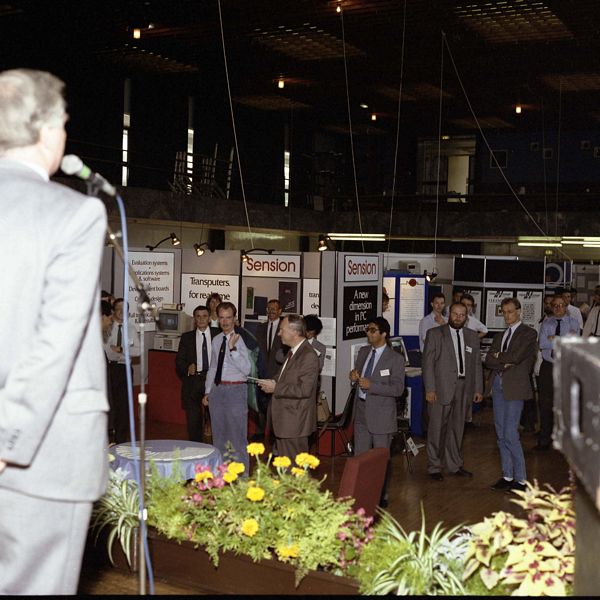
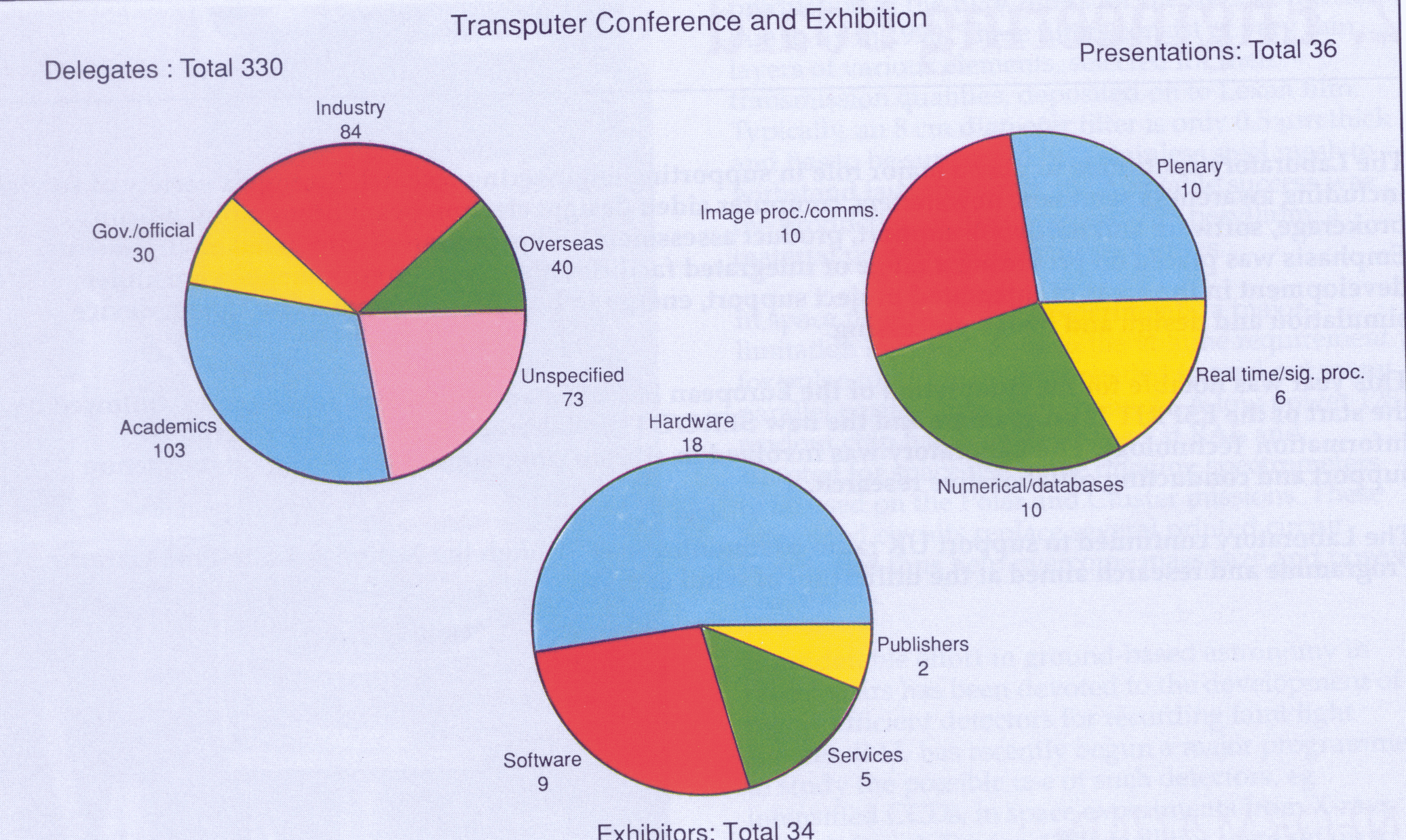
The keynote Conference speech from David May of Inmos envisaged potential future developments in Occam and the transputer. Such topics as modules, recursion, records and data-structures and user defined data-types were offered as food for contemplation by the software enthusiast. Hardware should include faster sequential processes, multiple on-chip processors, system-wide communications and addressing, and monitoring and error-handling.
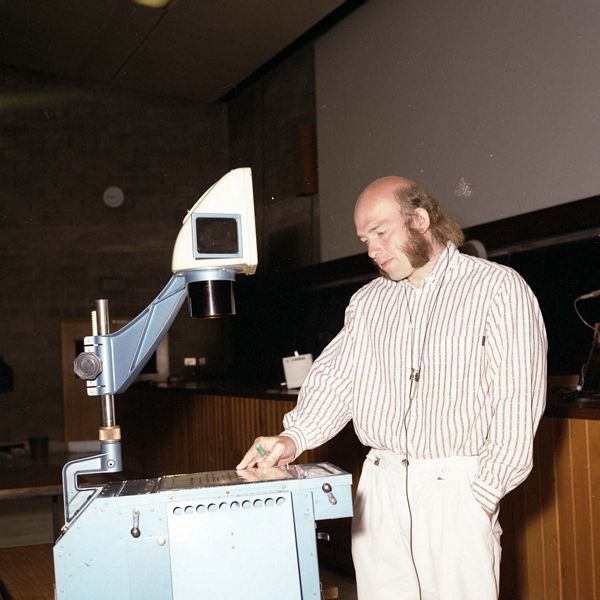
On applications the Conference included papers on satellite communications signal processing, 3D parallel graphics, simulation and database work.
The Exhibition gave opportunities for suppliers and manufacturers to exhibit many new products (Fig 2.2). Transputer modules (TRAMs) offering many exotic features were on show including graphics based on the new G300 graphics chip from Inmos and, less exciting but important in their own right, SCSI disk interfaces for direct storage connections to transputers.
There were a number of established and new development environments on show ranging from latest in-Sun products from Meiko and Transtech to new systems on Apollo, Gnome Computers (Acorn Archimedes) and Cogent Research from the USA with a workstation running the Linda-based Qix operating system.
The event was well received by participants, visitors and the Press. It set a standard for Southampton in 1990.
One of the liveliest areas in computing is the growth of the engineering workstation sector. Engineering workstations are powerful computers used by one person, offering the computing power of at least two or three times a VAX 780 and a screen for display and manipulation of high quality text and graphics in monochrome, grey scale or colour. Many purchasing decisions are based on prejudice, ignorance, too much attention to cost rather than value, failure to take a longer term view or persuasive salesmen. The Board decided that its EASE programme should provide engineers with assessments which are directly relevant to their intended use. The aim is to provide grant applicants with a list of approved machines and advice on which are most appropriate for a particular application.
Reports on assessments are provided in confidence to the relevant committees which decide which machines to add to the approved list. A Which style report is prepared for general distribution to Higher Education Institutes comparing performance of hardware and basic and application software, and the availability of relevant software (both application and library).
One of the reports this year was a repeat of last year's assessment of workstations running the Unix operating system whose power was roughly that of a Sun 3/60. The changes in the year have been considerable; the number of contenders has doubled and the power of the top machines increased by a factor 5 (Fig 2.3). The X window system is now commonly available. There are many more machines based on Reduced Instruction Set Computing (risc) chips, compared with last year when most used the Motorola 68020.
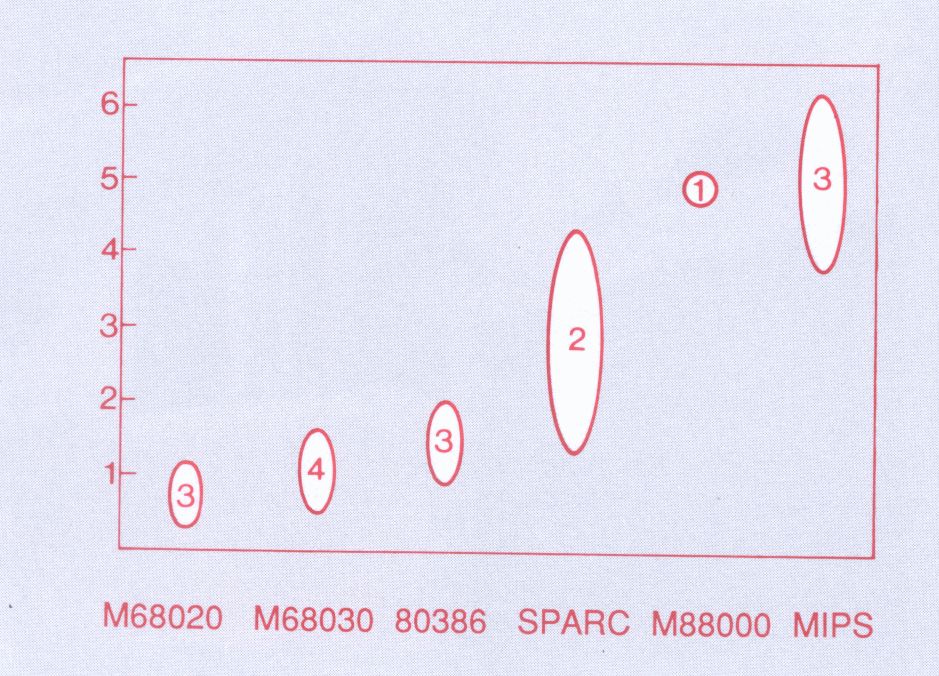
The following machines are currently on the approved list: Sun3, Sun4, S PARCstation (all from Sun Microsystems); VAXstation, DECstation (both from Digital); 6150 from IBM.
The third report concerned the multitude of machines based on the Intel 80386 chip. These tend to be enhanced PCs (and hence run versions of DOS) but the Unix operating system is available. However, the general conclusion was that these machines tend to be targeted at the business market and are lacking applications software specific to engineers. None of this class was recommended for approval.
IPSE 2.5 is an Alvey project which began in 1985 and completion is scheduled for 1990. It involves a consortium of RAL, the University of Manchester and five major UK companies under the leadership of STC Technology Ltd. IPSE, an Integrated Project Support Environment, provides support for the management and control of the processes involved in a complex project such as software development. A distinguishing characteristic of IPSE 2.5 is that it is providing a generic IPSE which can be instantiated to provide support for a particular method or methods. This is achieved by describing the development process associated with the method in a process modelling language, PML, and providing appropriate tooling.
The Manchester /RAL part of the project is concerned with formal methods of software development. Formal methods are those which use mathematical specification to capture the user's requirements, and mathematical techniques which enable the correctness of an implementation to be verified with respect to the specification. Such techniques may well become mandatory for certain kinds of safety critical software and their use in general software development may lead to reduced maintenance costs. Sophisticated tools are essential to the development of software by such methods to support the mathematical reasoning and for the management of complex specifications, refinements and proofs.
The Manchester University /RAL collaboration is developing a tool to support formal reasoning, µral. The system provides a prototype support environment for the Vienna Development Method (VDM) (now being processed as a BSI standard) and a sophisticated proof assistant. The aim was not to provide a fully automatic system but rather one that provides an assistant to the human responsible for carrying out proof steps who should, through his understanding of the problem, be able to guide the proof process along the right lines. User interface issues are of paramount importance in such a system and considerable effort has been devoted to this in the project. The proof assistant is sufficiently general that it can support any formal method.
RAL has recently concentrated on the design and development of the prototype VDM support environment in the system. Development steps in VDM revolve around finding more concrete representations for the datatypes of the specifications and redefinition of the functions and operations to correspond to these new datatypes. Each step gives rise to proof obligations, theorems which have to be proved to verify that the step is correct.
The project has aroused considerable interest in the academic and commercial worlds and points the way towards tools which will be usable by practising software engineers as well as highly trained mathematicians. This has to happen for formal methods to become useful tools for tackling the universally acknowledged software crisis.
There is much interest in and use of computing within the control engineering community. Over the last few years the CDTCE Management Committee, part of the Control and Instrumentation area, has funded and directed developments to provide a working environment for control engineers. This is known as ECSTASY, Environment for Control System Theory, Analysis and SYnthesis. ECSTASY has two aims: it provides a common interface to well established packages in the area, such as ACSL and ProMatLab and it provides a system in which new control algorithms can be developed. The common front end approach means that control engineers will not have to learn a new interface to use a new package while a common environment for new developments means that the results of such developments can be easily transferred to other researchers and to industry.
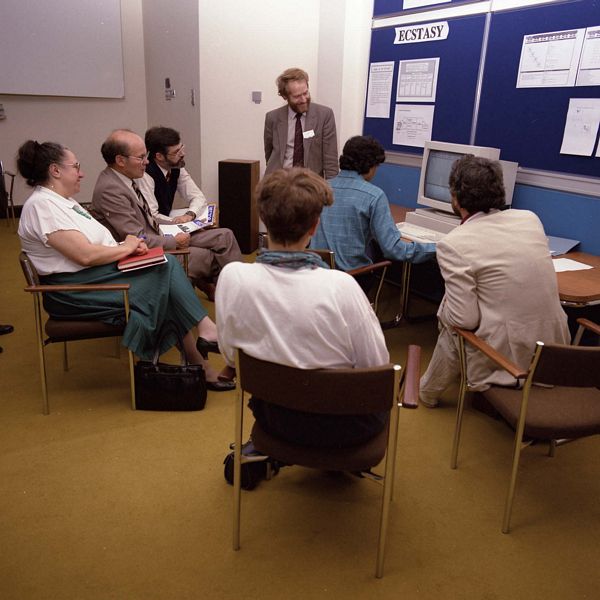
Much of the basic software has been written under contract by staff at the Control Systems Centre at UMIST, with software to provide a block diagram editor from University College, Swansea. RAL staff have been involved as consultants during the project definition and development phases of the project (Fig 2.4). They have also worked on interfacing the TSIM simulation package to ECSTASY. More recently RAL staff have organised and supported two beta tests for the software and run a course at RAL for new users of the system. Plans have also been made to involve a UK company in exploiting the system. It is intended that ECSTASY be marketed world-wide, although initially efforts will be concentrated on the UK and the rest of Europe.
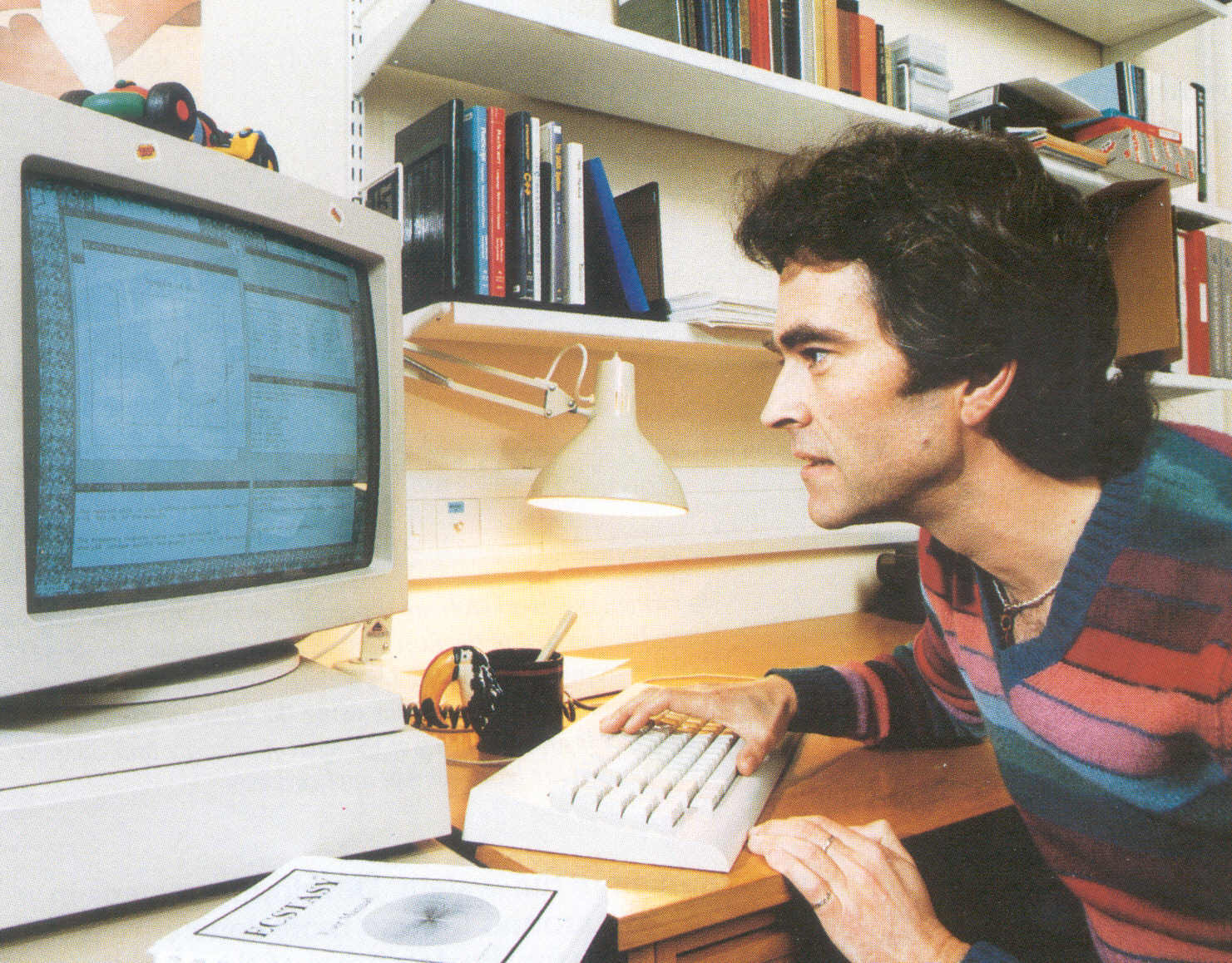
IPAL, an Image Processing Algorithm Library, is a collaborative Alvey project in the Man-Machine Interface programme. The collection of algorithms is based on contributions from Alvey projects, astronomy groups at RAL, MRC Edinburgh and many others. New implementations of published algorithms have also been written. An early decision was taken to generate two distinct libraries (written in Fortran and C) rather than two bindings of the same functions. It is therefore possible to target algorithms at the most appropriate language. In particular, the Fortran library handles two dimensional rectangular arrays of real values whilst C uses the more flexible data structures available in that language. This has the effect of putting algorithms for the later stages of processing, where features of images are being processed, into the C library (Fig 2.5).
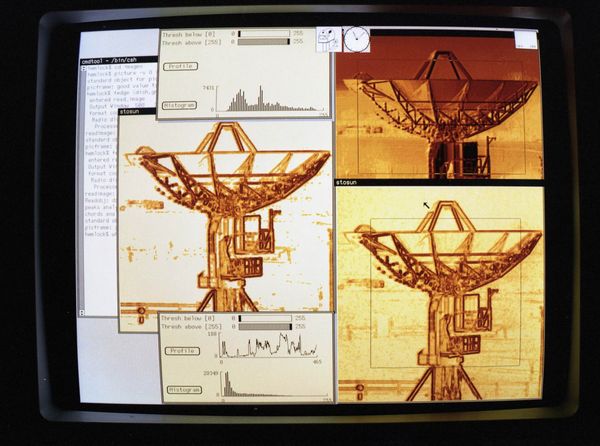
A comprehensive Fortran library now exists which is fully documented to the standards expected from other NAG libraries. As well as the basic utility routines there are 'chapters' on intensity transforms, geometric transforms and registration, filtering, enhancement and restoration, edge detection, morphological processing and object geometry, segmentation and labelling and on texture analysis. Simple input/ output and GKS interface routines have been included to make the library as self contained as possible.
The C library has reached the stage of a trial release of its utility routines. This library has a more comprehensive set of object geometry routines, reflecting the fact that its major contribution is from the medical area.
More contributions are needed for both libraries but it is believed that viable libraries now exist which, with further development, will lead to successful commercial products.
Within the Laboratory a successful collaboration between the Knowledge Engineering Group in Informatics Department and the OPAL Group in Particle Physics Department has led to the development of a working expert system for configuring a complex physics experiment. The OPAL detector at CERN contains several hundred devices controlled by several MicroVAXes, about fifty M68020 microprocessors and many local devices, the entire complex being controlled by a central VAX minicomputer. There is a need for coordinating the activities in the different parts of OPAL. It was felt that an approach using knowledge-based systems would be effective because the resulting system should be easier to maintain and offer better management of complexity as the system was scaled up, a recognised problem. Knowledge engineers worked with experimentalists to develop a prototype which, after enhancement, has realised the expected benefits.
The problem was defined to be the development of a tool which would configure the devices required to perform a particular type of physics and permit a new type of physics or, more specifically, to configure the processes such that state transitions happen in an orderly way. The system was intended to be used by the single operator of the detector, a physicist who would specify the desired goal state.
The heuristic rules often employed in knowledge based systems were not applicable because there was no relevant body of expertise available. Instead, a more general method was chosen based on transition networks which had the advantage of being close to the physicists' own schematic representation of a process diagram showing dependencies. Each process was equated to a device with a set of states and associated conditions and actions, so that transitions could take place when conditions were satisfied and would be initiated by the actions. Easy maintainability of the knowledge base was achieved by having a special language for describing the characteristics of devices. In this way it is simple to add new devices or modify existing ones.
A prototype system was developed using a commercial expert system shell on an IBM PC. Its output was a file of DCL commands to the VAX to execute the required configuration. This is an approach commonly used because it produces results quickly. The prototype was then rewritten in Prolog, a language well suited to this kind of application and which is portable across many computers. It has now been taken over by the users on their VAX. They have added a graphical interface and loadable external functions and made it possible to issue commands over communications links to initiate state transitions. The system is thus communicating with and controlling devices which act in real time. The system is in routine use to control data collection within the experiment.